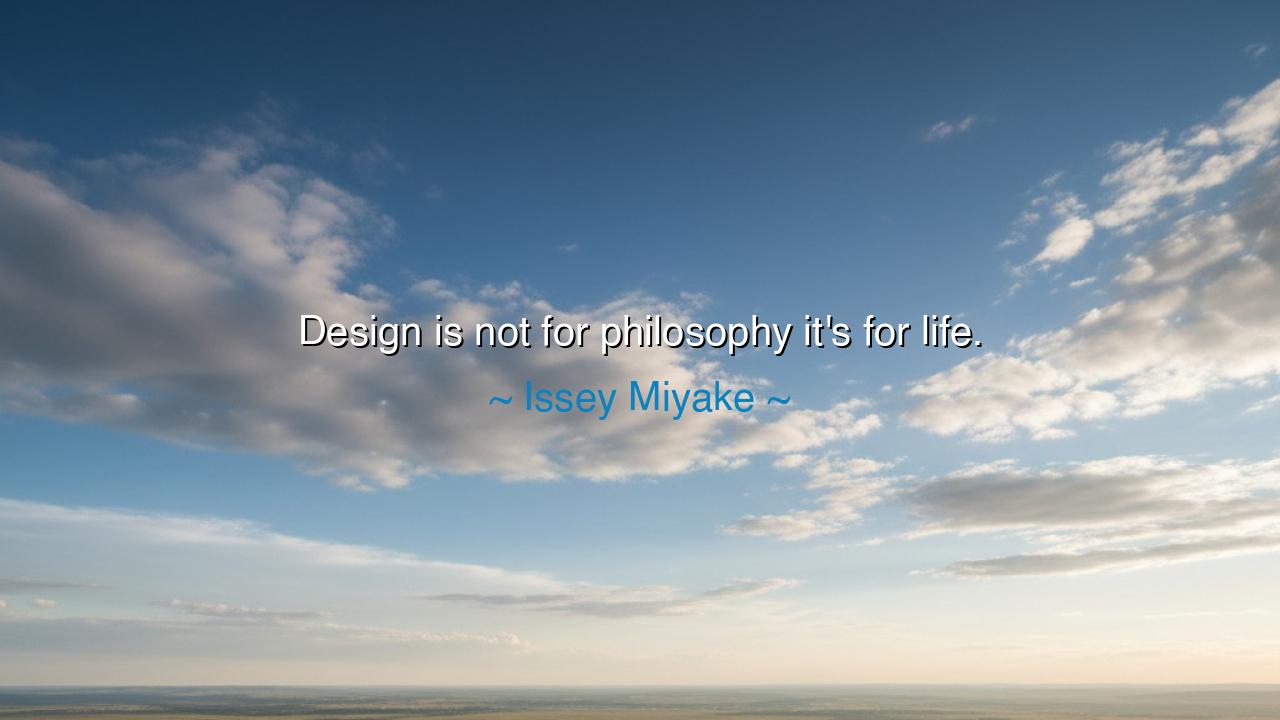
Design is not for philosophy it's for life.






“Design is not for philosophy, it’s for life.” So spoke Issey Miyake, the visionary who wove the language of form into the rhythm of living. His words cut through abstraction like sunlight through mist, revealing a truth as ancient as creation itself: that design is not meant to dwell in lofty thought, but to serve existence, to walk hand in hand with the pulse of humanity. For life, not theory, is the true canvas of design. The cup that holds water, the robe that shelters the body, the bridge that carries travelers — these are not born of idle musings, but of the deep desire to sustain, uplift, and ennoble human experience.
The philosophers of old pondered the nature of beauty, form, and function. Plato spoke of ideals that dwell beyond the reach of matter, while Aristotle brought beauty down to purpose — to harmony between what a thing is and what it does. Miyake, standing centuries later amid the hum of machines and the whisper of fabric, chose the latter path. He saw that true beauty is not imprisoned in contemplation; it breathes when touched, moves when worn, serves when used. His designs — light as air, flowing like wind — were not made to be admired in stillness, but to accompany the living in motion. They were philosophy made flesh, though he would reject the term. For him, life itself was the only philosophy worth designing for.
To understand his words, one must understand his journey. Born in Hiroshima, Miyake witnessed the devastation of his homeland — a place where even the air had turned to sorrow. From those ashes, he resolved to create not symbols of despair, but expressions of renewal. His designs spoke of rebirth, of form that adapts and endures. When he created his famous Pleats Please garments, he did not seek to impress the intellect, but to liberate the body — to give people freedom of movement, freedom of comfort, freedom of expression. It was design for life, not for galleries or museums, but for the pulse of everyday being.
He knew that the truest art is the art that serves. The potter’s bowl, the tailor’s cloth, the craftsman’s tool — these humble things carry the weight of civilizations. They do not speak in words, but they speak nonetheless. The temples of Greece, the arches of Rome, the tea cups of Japan — each was born from the same sacred impulse: to bring grace to the acts of living. This is what Miyake meant. Design, in its highest form, is not decoration; it is service — a quiet devotion to the dignity of life itself.
Too often, modern man forgets this. We adorn without purpose, we build without need, we pursue beauty as an idol rather than a companion. Miyake’s wisdom calls us back to balance. He reminds us that utility and beauty are not enemies, but partners in creation. The chair that invites rest, the lamp that offers warmth, the garment that comforts the skin — these are not lesser arts because they serve; they are greater because they unite function with feeling, necessity with grace. A life surrounded by such thoughtful design becomes a life of quiet harmony.
Think of the Japanese tea ceremony, a ritual in which every cup, every gesture, every pause has been designed not for grandeur but for mindfulness. The cup fits perfectly in the hand, the steam rises gently, the silence between motions becomes sacred. There is no philosophy written upon the walls, yet wisdom fills the air. This is what it means when we say design is for life — not to theorize, but to make life itself more intentional, more beautiful, more humane.
So take this as your lesson: live as a designer of your own existence. Let every choice you make — the way you arrange your space, the way you speak, the way you move through the world — be guided by purpose and compassion. Ask not only, “Is this beautiful?” but also, “Does this serve?” “Does it bring peace?” “Does it honor life?” To design your surroundings, your work, and your relationships with such awareness is to turn living itself into an act of art.
And remember the truth Miyake offered: design is not for philosophy — it is for life. Life that breathes, that walks, that struggles and rises again. Life that reaches for harmony amidst chaos. When you design — be it a garment, a home, or a single moment of kindness — let it be an offering to the living spirit of the world. For in serving life, you do the greatest act of creation: you shape meaning itself, and give it form that endures beyond thought, beyond time.






AAdministratorAdministrator
Welcome, honored guests. Please leave a comment, we will respond soon